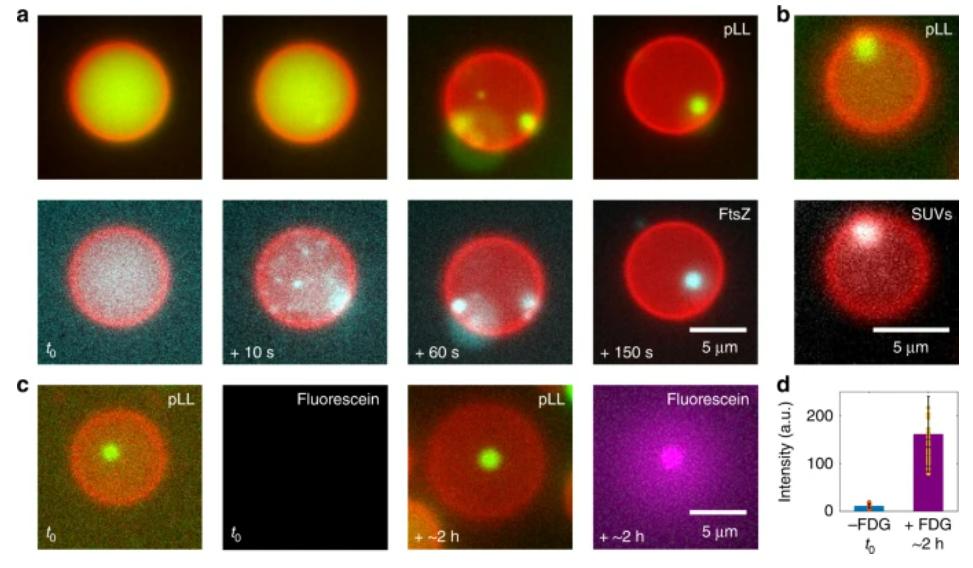Liposome Localization Service
As a popular drug carrier, liposomes have been widely used in various clinical applications such as drug delivery and controlled release. Developing effective liposome tracers can help monitor drug delivery and release processes.
Leveraging our extensive expertise in liposome research, Creative Biostructure employs various liposome tracking technologies to conduct research on monitoring liposome positioning. This service provides innovative insights for the development and functional research of liposomes to our customers.
What is Liposome Localization?
Liposomes are made of phospholipids as a membrane material. Phospholipids are the basic material for forming liposome bilayers and have good biocompatibility. Liposomes have a similar structure to cell membranes (bio membranes). The main components, phospholipids, and other lipids, are the main components of cell membranes, so liposomes have a strong affinity with cell membranes. Upon fusion with the biological membrane, liposomes release their active ingredients, allowing them to enter cells. Alternatively, cells may engulf the entire liposome, absorbing the active ingredients within.
Liposomes are artificially prepared microsomes containing a lipid layer and can be used in many fields, such as drug delivery, gene delivery, and vaccine delivery. Liposomes have good biocompatibility and biodegradability in the body, which can improve the bioavailability and targeting of drugs, genes, and vaccines and reduce side effects and toxicity. Therefore, liposomes have been widely studied and applied in recent years. As a commonly used nanodrug-carrying system, liposomes have been used for drug delivery since their discovery; leveraging the biocompatibility and well-understood chemistry of liposomes, they successfully encapsulate and deliver targeted delivery of a variety of APIs. Therefore, finding suitable liposome tracing and imaging methods to achieve effective and stable liposome tracing is beneficial to studying drug delivery and release processes.
 Figure 1. pLL/ATP condensates (green) formed within liposomes (red). (Deshpande S, et al., 2019)
Figure 1. pLL/ATP condensates (green) formed within liposomes (red). (Deshpande S, et al., 2019)
What Can We Offer?
Creative Biostructure offers a range of liposome tracing and imaging methods, such as microscopic, radioactive, magnetic resonance, and fluorescent tracers. These methods observe cellular compartmentalization and the interaction between the drug-loaded system and cells to provide comprehensive information. Additionally, we provide various fluorescent liposomes for tracking and detecting liposome distribution:
| Fluorescent | Ex/Em |
| DiA | 456/590 nm |
| DiD | 644/665 nm |
| DiI | 549/565 nm |
| DiO | 484/501 nm |
| DiR | 750/780 nm |
| NBD headgroup tagged lipid | 460/535 nm |
| NBD fatty acid tail tagged lipid | 460/534 |
| rhodamine headgroup tagged lipid | 560/583 nm |
| dansyl headgroup tagged lipid | 336/513 nm |
| pyrene headgroup tagged lipid | 351/379 nm |
Highlights of Our Liposome Localization Service
- Cutting-Edge Liposome Expertise: Benefit from our leading-edge proficiency in liposome research, unlocking unparalleled insights for the advancement of liposomal technologies.
- Precision Tracking Technologies: Utilize our state-of-the-art liposome tracking technologies to ensure precise monitoring of liposome positioning, offering a distinct advantage in research applications. A diverse range of fluorescent indicators is at your disposal for efficient liposome tracking and imaging.
- Cost-effective Solution: Our service distinguishes itself through a commitment to cost-effectiveness, ensuring that you receive the most accurate results at an optimal price point.
- Tailored Comprehensive Solution: Discover customized solutions crafted specifically for the development and functional investigation of liposomes. Our specialized services provide a one-stop solution, guiding your research endeavors to unveil the multifaceted applications of liposomes, ranging from drug delivery and gene delivery to vaccine delivery.
Creative Biostructure has rich experience in liposome research, and we provide high-quality liposomes and modification and functional research and tailor-made research solutions for customers to meet specific needs. We are committed to providing our customers first-class service and eagerly look forward to becoming your partner in the liposome research process. Please feel free to contact us for a detailed quote if you're interested in our services.
Ordering Process
References
- Man F, Gawne P J, de Rosales R T M. Nuclear imaging of liposomal drug delivery systems: A critical review of radiolabelling methods and applications in nanomedicine. Advanced Drug Delivery Reviews. 2019, 143: 134-160.
- Deshpande S, et al. Spatiotemporal control of coacervate formation within liposomes. Nature Communications. 2019, 10(1): 1800.
- Saeed-Zidane M, et al. Cellular and exosome mediated molecular defense mechanism in bovine granulosa cells exposed to oxidative stres. PloS One. 2017, 12(11): e0187569.
- Pouget M, et al. Generation of Liposomes to Study the Effect of Mycobacterium Tuberculosis Lipids on HIV-1 cis-and trans-Infections.International Journal of Molecular Sciences. 2021, 22(4): 1945.
